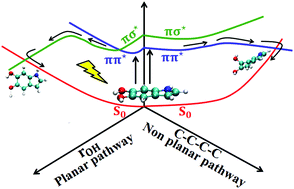In order to understand the photoprotection process in eumelanin, it is imperative to understand the photoprocesses in its monomers. Eumelanin is a polymeric structure made of di-hydroxyindole (DHI) as the basic motif. There have been studies on the ground and low-lying excited state potential energy surfaces (PESs) and a few of the important modes have been identified in the eumelanin monomer. However, to properly depict the fate of a molecule after an initial photoexcitation, it is important to look at the dynamical picture and in this work, we have studied the excited state dynamics of a eumelanin monomer. We observe that there are planar OH elongation modes that can be important for the de-excitation mechanism. There are also non-planar modes that distort the phenyl ring of the DHI molecule. In the excited state dynamics, it is the non-planar modes that are more relevant to the non-radiative deactivation process of the monomer. We further notice that due to the non-planarity in the molecules along the deactivation path, the excited states involved in the processes are mixed ππ* and πσ* in nature. Furthermore, it is noticed that this deactivation process occurs well below a ps timescale.
